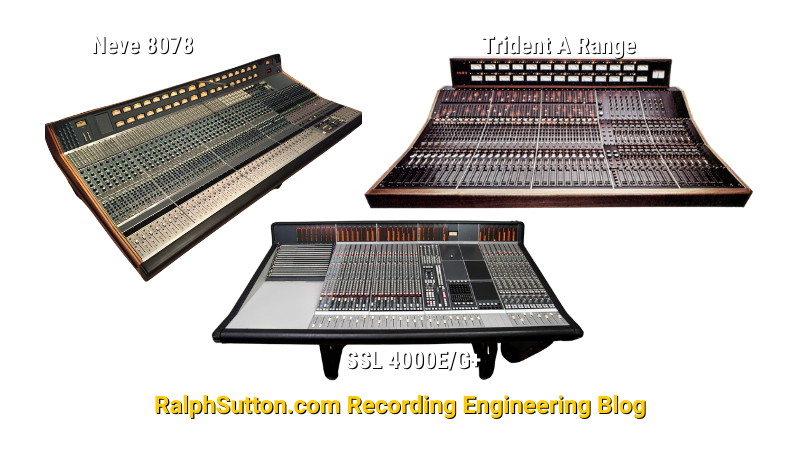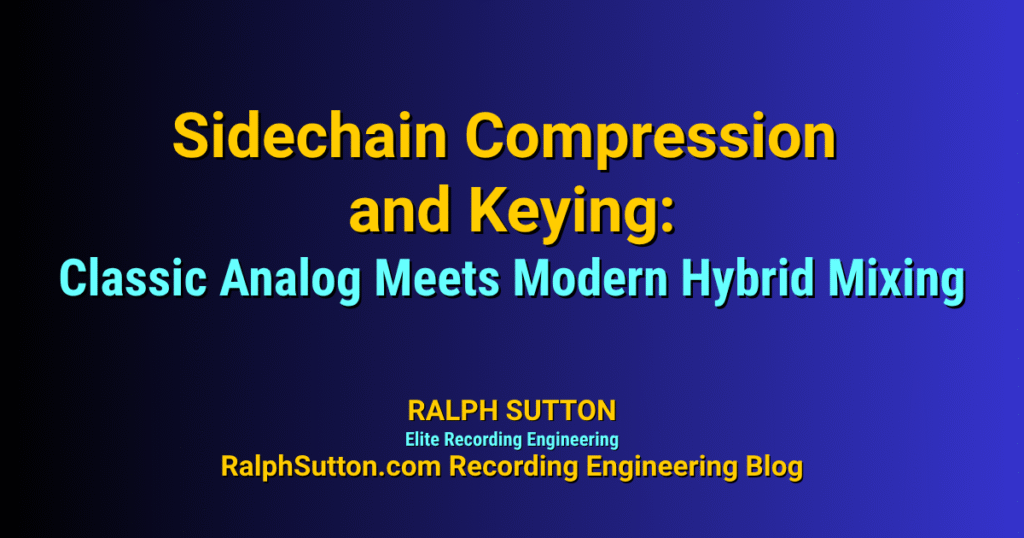Sidechain Compression and Keying: Classic Analog Meets Modern Hybrid Mixing
In the world of modern mixing, “sidechain compression” is often treated like a gimmick, a flashy trick for making your kick drum pump the whole track in an EDM session. But that’s just one small application. Real engineers, especially those of us who came up on analog consoles and racks, know this technique has deep roots in musicality, not just movement.
Sidechain compression and keying is a powerful way to shape the feel of a mix, create space, and preserve the groove when it’s done with intention.
I learned this technique back in the early 1980s from the engineers who mentored me, long before Pro Tools or plugin presets. We used it on Neve, API, and Trident consoles, with gear like the 1176, DBX 160X, LA-2A, and early VCA-based compressors. It wasn’t about showing off; it was about serving the music, enhancing the pocket, and controlling dynamics in a musical way.
And today, I still use those principles whether I’m working with analog tape, Pro Tools, or both
So what is Sidechain Compression and Keying, exactly?
→ Sidechain compression is when one signal controls the compression of another.
→ Keying is another word for this same technique using a separate audio source (the “key input”) to trigger a compressor.
The compressor isn’t just reacting to the signal it’s inserted on. It’s listening to a different track, and that gives us a huge creative advantage in shaping how elements interact.
This post will walk you through how I use sidechain compression and keying:
✅ In full analog signal chains
✅ In Pro Tools and hybrid workflows
✅ Across genres like jazz, funk, R&B, and gospel
→ always with one goal in mind: protect the pocket and serve the groove.
Why I Use Sidechain Compression: Pocket First
For me, sidechain compression isn’t about gimmicks, it’s about preserving the pocket.
When a mix starts to feel crowded or washed out, it’s usually not because of too many tracks. It’s because the elements aren’t respecting each other’s space. That’s where sidechain compression becomes a musical tool, not a technical trick.
The Pocket Is Sacred
In Jazz, Funk, R&B, Gospel, and Soul, the pocket is everything. It’s the pulse, the breath, the heartbeat of the track. The moment your mix starts stepping on itself, whether it’s the kick fighting the bass, or the vocals getting buried under keys and pads, you’ve lost the groove.
But if you use sidechain compression correctly, you can carve dynamic space without flattening the mix. You can make the bass duck ever so slightly when the kick hits, not to create a “pumping effect,” but to let the impact of the groove come through. You can subtly key the lead vocal into background instruments so it breathes naturally without fighting for attention.
I was taught to use sidechain compression like a dancer leads a partner, guiding the motion without force. That philosophy has never left me.
How Sidechain Compression and Keying Preserves the Groove
Too many engineers today use sidechain compression like a sledgehammer, just slamming the listener every time the kick hits. That’s not music. That’s programming.
My approach is different:
Subtle ducking between kick and bass
Smooth vocal-to-keyboard shaping
Pocket-preserving moves that don’t scream “sidechain,” they just feel good
Whether I’m mixing through hardware, using Pro Tools, or doing a hybrid of both, the goal is always the same:
Shape the feel, not just the sound.
Preserve the groove, not flatten it.
“Sidechain compression isn’t about volume control. It’s about relationship control, how each element moves around the other.” -Ralph Sutton
Key Analog Examples of Sidechain Compression and Keying
I was using sidechain compression and keying long before Pro Tools existed, back when you had to use patch cables and think like an engineer, not just click a preset. That foundation shaped the way I still work today.
Here are some of the analog tools I’ve used for decades to get this right and how I still use them when the session calls for it.
1176 with Sidechain Filter
The 1176 isn’t traditionally known for sidechaining, but you can modify the signal chain using a high-pass filter in the sidechain path (commonly done with modern mods or through console routing). This keeps the low end, like kick and bass, from falsely triggering the compression.
Real use: I’ve used this to control electric piano comping without messing with the groove between the kick and bass.

LA-2A Keyed by a Separate Source
The LA-2A is optical and slow, but beautiful when used with a key input routed from another track. I’ve keyed it with a vocal guide to tame sustained pads or percussion to rhythmically control a reverb return.
Real use: Gospel vocal beds that swell too hard get gently floated with this technique

DBX 160X with External Key Input
The DBX 160X has a dedicated external key input perfect for tightening grooves. I’ll run a kick drum into the key input and have it compress a bass guitar just slightly.
Real use: Funk tracks where the bass and kick are dancing, I let the kick lead without muting the bass’s vibe.

Tube-Tech SMC 2B with External Key
The Tube-Tech SMC 2B is a high-end, all-tube multiband compressor that doesn’t have a dedicated sidechain key switch on the front panel like some VCA units. But that doesn’t mean it can’t be keyed. I use it by patching an external signal into the detector path via console inserts or through a DAW hardware interface loop, depending on the routing setup.
It takes a little more intention and setup, but the results are musical and powerful, especially when you want frequency-specific compression across a stereo image, without flattening the mix.
Real use: I’ve re-routed a lead vocal, snare, or even a solo instrument into the SMC 2B’s detection path, letting it gently shape the horns, background vocals, or rhythm section in real time. It glues the mix with tone, not just control.
This is one of those pieces where knowing how to engineer the patching makes all the difference. There’s no shortcut, but the sound is undeniable.

Console Routing Tricks
On analog consoles like Neve, API, and Trident boards, I use bus routing and insert returns to create creative keying paths. I can group background vocals and key them from a solo instrument to make space dynamically, without automation.
Real use: Jazz sessions where I want a soloist to come through naturally during a B-section without hurting the vibe.

How I Apply This in Pro Tools and Hybrid Workflows
The tools may have evolved, but the mindset hasn’t changed. Whether I’m working in Pro Tools, on a large-format analog console, or using both, my approach to sidechain compression stays rooted in musicality.
How I Use Sidechaining in Pro Tools
Compressor Plugins with External Key Input: Tighten bass when kick hits just like my DBX chain, but in the box.
Dynamic EQ Sidechaining: Duck specific frequency ranges, not whole tracks.
Vocal-Controlled Keying: Vocal subtly keys pads or reverbs for clarity and lift.
Filtered Key Inputs: Always high-pass the key to avoid low-end mud triggering compression.
What I Mean When I Say I’m a Hybrid Engineer
When I describe myself as a Hybrid Engineer, here’s what I mean:
I use analog tape to record full sessions, not just rhythm sections, but vocals, keys, horns, and percussion.
I transfer audio into Pro Tools to lock in that analog tone and gain modern flexibility.
I use analog outboard gear within Pro Tools to add depth and musicality to the mix.
For Dolby Atmos, I may reamp stems through 24-track analog tape to recreate room tone, inject analog ambiance, or apply tape saturation to bring soul into a digital field.
Being a Hybrid Engineer means I adapt to the production’s needs and budget, without ever sacrificing the integrity of the music.
“I’ve worked this way since the early days of DAWs, always pushing myself to learn more, do more, and create more, both for myself and for the artists I serve. As a Hybrid Engineer, I’m committed to delivering timeless recordings with character, warmth, and soul.” -Ralph Sutton
Real-World Applications: By Genre
Jazz: Kick vs. Bass Pocket
Use sidechaining to let the kick breathe through the upright bass without losing body.
Funk: Rhythm Guitar and the Pocket
Key guitar parts from snare or hi-hat to keep the groove clean and the pocket tight.
R&B: Lead Vocals and Background Textures
Use the lead vocal to key soft pads or synths, giving it space without automation.
Gospel: Dynamic Backing Vocals
Group BGVs and key them off the lead to ensure message clarity while maintaining power.
Room FX and Reverb Ducking
Sidechain reverb/delay returns from their dry source to create depth that breathes.
These moves aren’t about showing off, they’re about making the groove feel alive.
Final Thoughts: Respect the Groove
Sidechain compression and keying aren’t about chasing trends. They’re about making space for the music to speak.
Used with care, they help you:
Protect the groove
Clarify dynamic relationships
Add movement
Let each part breathe
Use this tool to shape feel, not just sound. The pocket is sacred. This is how I protect it.
FAQ: Sidechain Compression and Keying
1. What is sidechain compression, and how is it different from regular compression?
Sidechain compression uses an external signal to trigger compression on another track, often to carve space or create rhythmic movement.
2. What’s the difference between sidechain compression and keying?
They’re the same technique. “Keying” is the classic analog term. “Sidechain” is the modern DAW term.
3. Why do you prefer using sidechain compression in a hybrid workflow?
Because I can blend analog warmth with digital control, shaping both tone and feel.
4. Is sidechain compression only useful for EDM and pumping effects?
No. In real music, Jazz, Funk, R&B, Gospel, and Soul, it’s used for subtle control and groove clarity.
5. Can I use sidechain compression in Pro Tools without analog gear?
Yes. Most modern compressors allow sidechain input routing. Plugins like FabFilter Pro-C 2 and stock Avid Dynamics make it easy.
6. When should I avoid using sidechain compression?
Avoid it when it becomes distracting, unnatural, or when it’s being used to fix arrangement problems instead of mix balance.
🎯Want your next project to groove with clarity, warmth, and pocket-first energy?
As a Hybrid Recording and Mixing Engineer with over four decades of experience, I bring analog feel and digital flexibility to every session, whether it’s Jazz, Funk, R&B, Gospel, or Soul Music.
🎛️ Whether you’re recording in LA or mixing remotely, I can help shape your sound with the same sidechain compression and keying techniques I’ve shared here.
👉 Let’s work.
Click here to book recording, mixing, or production services.
Let’s create something timeless.
